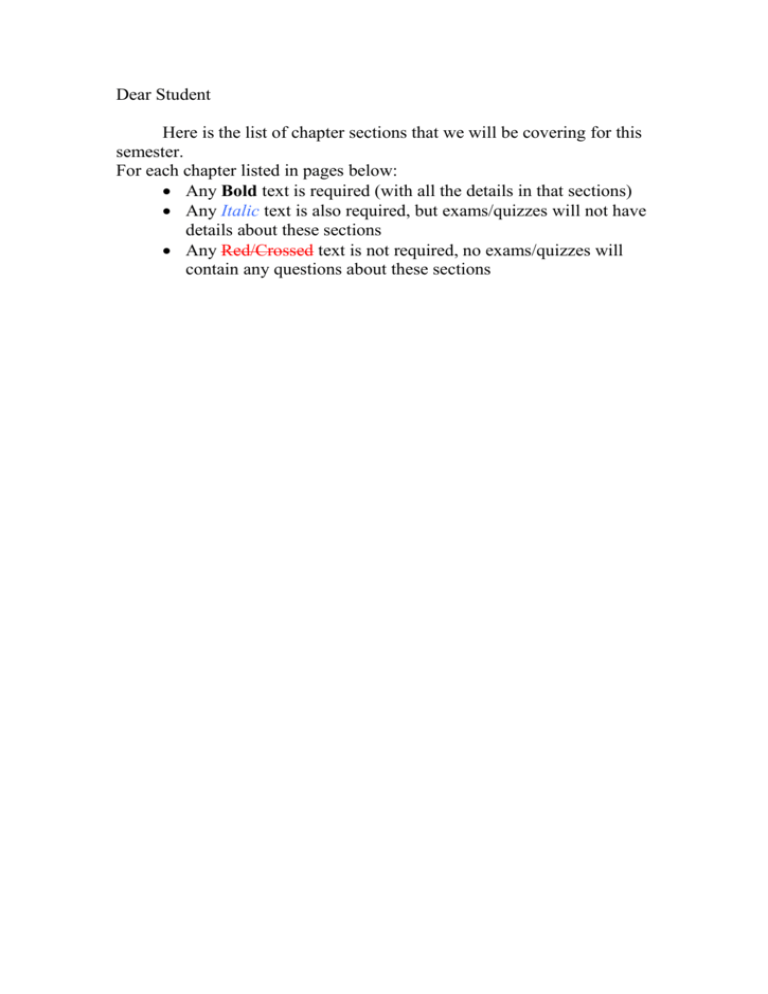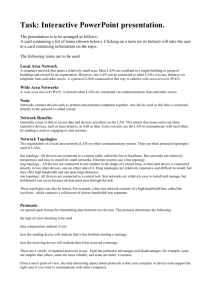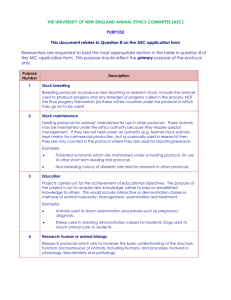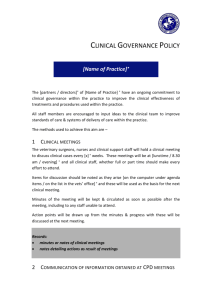Here is the chapter list for he course
advertisement

Dear Student Here is the list of chapter sections that we will be covering for this semester. For each chapter listed in pages below: Any Bold text is required (with all the details in that sections) Any Italic text is also required, but exams/quizzes will not have details about these sections Any Red/Crossed text is not required, no exams/quizzes will contain any questions about these sections Chapter 1: Introduction to Communications What is Data Communications? Data Communication Networks Basic Components of a communications system The telephone System Data Communications and the Telephone System Common Carriers IntraLATA calls InterLATA calls Governmental and Regulatory Agencies Standards Organizations Chapter 2: Fundamentals of Data Communications Signal Representation Bit Rate Baud Rate Frequency Bandwidth Digital Signals versus Analog Signals Modems Data Codes ASCII EBCDIC Unicode Telecommunications – Voice communications The telephone The telephone Netwrok Telephone Calls Telephone Lines Telephone Signals Exchange Codes Country Codes 800 Service 900 Service Dial Around Services Chapter 3: Communications Media, Servers, and Clients Guided Media Unguided Media Selection of Media Cost Speed Rate of Errors Security Computers and Terminals in a communications network Computers in a network Mainframe Computers and supercomputers Midrange Computers Personal Computers Clients (terminals) Special-purpose Terminals Remote Input Clients Engineering Industry Clients Network Configurations Point-to-point Midpoint Terminal Interfaces Handshaking Chapter 5: Data Transmission Analog Modulation Amplitude Modulation Phase Modulation Quadrature Amplitude Modulation Digital Modulation Using Analog Signals to Transmit Digital Data Using Digital Signals to Transmit Analog Data Using Digital Signals to Transmit Digital Data Transmission Directions Simplex Transmission Half-Duplex Transmission Full-Duplex Transmission Transmission Modes Serial Transmission Parallel Transmission Synchronization Asynchronous Transmission Synchronous Transmission Data Synchronization Errors Sources of Errors Impulse Noise White Noise Attenuation Crosstalk Delay Distortion Line Failure Error Detection Parity Checking Cyclic Redundancy Check (CRC) Error Correction Forward Error Correction Error Detection with Retransmission Error Control Standards Error Prevention Digital Transmission Chapter 6: Protocols The Role of Software in a network Protocols Open System Interconnection (OSI) model Types of Protocols Wide Area Network Protocols Mainframe Computer Protocols Character-Oriented Protocols Byte-Count-Oriented Protocols Bit-Oriented Protocols System Network Architecture (SNA) H.323 Protocol x.25 Protocol Interment Protocols Transmission Control Protocol/Interment Protocol (TCP/IP) Internet Protocol Version 6 Other Internet Protocols Electronic Mail Protocols Local Area Network Protocols X.PC Ethernet Token Passing Internet work Packet Exchange/Sequenced Packet Exchange (IPX/SPX) Wireless Protocols and Standards Cellular Digital Packet Data (CPPD) Wireless Application Protocol (WAP) Infrared Data Association (IrDA) Third Generation (3G) of Mobile Communications Bluetooth Enhanced Data Rates for Global Evolution (EDGE) SyncML Apple Talk Protocol Chapter 8: Wide Area and Metropolitan Area Networks Network Connections Point-to-Point Connections Topologies Wide Area Network Topologies Hierarchical Topology Star Network Ring Networks Metropolitan Area Network Topologies Bus Topology Ring Topology System Network Architecture Advance Program-to-Program Communication (APPC) System Application Architecture Common User Access Common Programming Interface for Communications Common Communication Support The SAA Layers Model Digital Network Architecture DNA Structure Model EnVISN Architecture Electronic Commerce Data Warehousing Business-TO-Business (B2B) Initiatives Electronic Data Interchange ZML and EDI Components EDI EDI Standards Advantages of EDI Metropolitan Area Network Implementation MAN Layers Architecture Municipal MAN School District MAN Chapter 9: Local Area Networks LAN Hardware Personal Computer Network Interface Card Transmission Medium LAN Standards LAN Topologies Ring Topology Bus Topology Star Topology Protocols Ethernet Token Passing Token Ring Network Token Bus Network Apple Networks AppleTalk Network Appleshare IP Network Types of Networks Private Branch Exchange LANs Peer-to-Peer LANs Server-Based LANs Wireless LANs LAN Software Network Operating Systems Novel NetWare LANtastic Windows NT/2000/2003 Linux High-Speed LANs Fast Ethernet Gigabit Ethernet Connection Networks Repeaters Bridges Routers Gateways Chapter 10: Network Security Physical Security Measures to Control Physical Access to Networks Data/Network Security Equipment Software Security IDs and Passwords Encryption Symmetric Key Encryption Public Key Encryption Elliptic Curve Cryptography Digital Signatures Digital Certification Secure Sockets Layer (SSL) Security Issues Forms of Computer Attacks Firewalls Chapter 12: The Internet History of the Internet Early Internet Commands Telnet File Transfer Protocol (FTP) Gopher Archie Veronica Internet Addressing IP Addresses Domain Name System (DNS) Electronic Mail Addresses How the Internet Works Routers Servers Protocols Word Wide Web Web Programming Web Browsers The Future of the Web Other Internet Services Search Programs Newsgroups and Mailing Lists (LISTSERVs) Newsgroups Mailing Lists Chapter 14:E-Business Applications and The Business Data Communications Industry The Impact of Business on Data Communications E-Business and Information Technology E-Business for Business E-Business for Consumers Interactive Television (ITV) Standards Wireless Technology Advanced Mobile Phone Service Time Division Multiple Access Code Division Multiple Access Cellular Digital Packet Data Global System for Mobile Communication (GSM) IMT-2000 Wireless Application Protocol (WAP) Other Standards Intranet and Extranet Groupware Real-Time Groupware Asynchronous Groupware Chapter 15: Addressing the Challenge of Living in a Connected World Emerging Technologies Ultra Wideband Technology (UWB) Wireless Hotspots Radio Frequency IDs E-Services Living in a Connected World Advantages Disadvantages Challenges Careers in a Connected World






